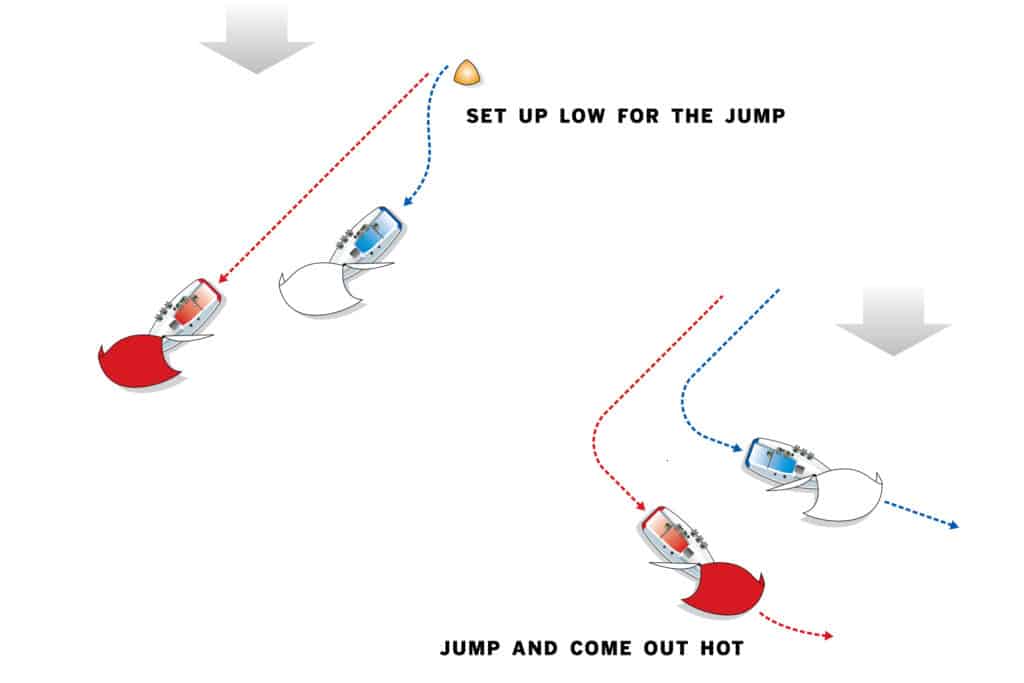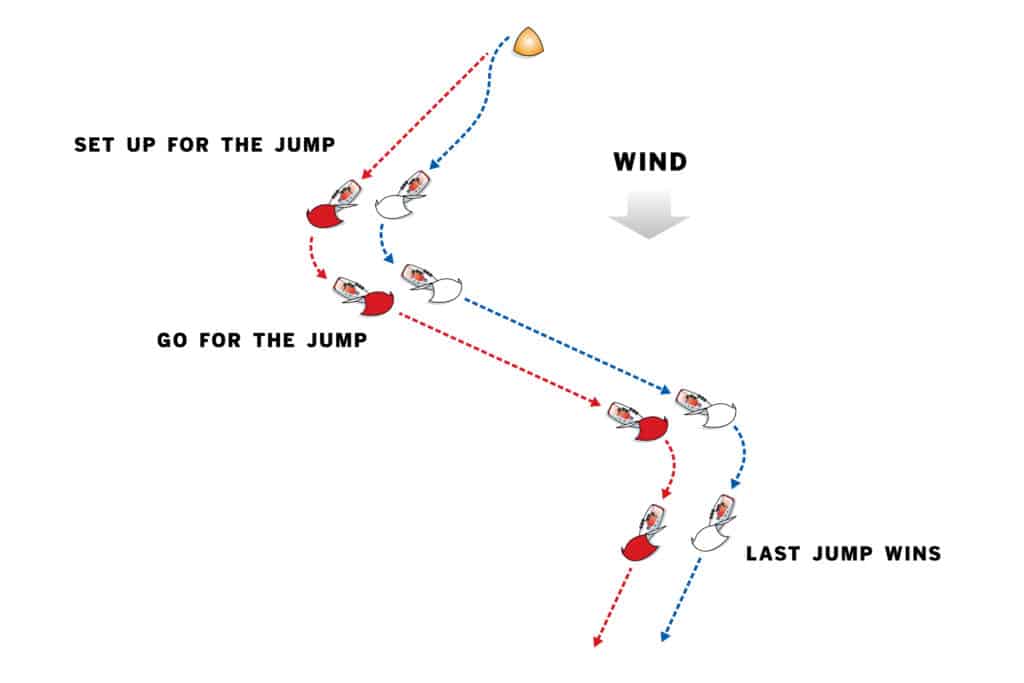
After a stint at the Chicago Match Race Center and winning the Congressional Cup with Ian Williams, I had my eyes opened to using match-race tactics in fleet racing to shave points from my scorecard. The beauty of match-race tactics is that they don’t have to be used against one boat; you can target a group of boats or the entire fleet. Here are a few plays I use.
Attack on the Final Run
Bill Hardesty taught me the value of passing boats on the way to the finish, especially downwind.
Hardesty is always in attack mode. If a boat (or a small group of them) is close ahead, you can bet he has his sights on it. One on one, attack-mode tactics are best on the final run, when the fleet is spread. If you’re in a tight pack or it’s early in the race, match-racing tactics have the risk of losing many boats, so remember that you’re trying to win the war, not the battle.
If you’ve worked low on a group ahead and everyone is approaching the time to jibe, feel free to jump the entire group as if it were one boat. The key to passing is to jump them in a jibe, stealing their breeze and rolling them. To set up to do so, you must initially work low on the boat ahead so you’re positioned to leeward and behind, lower than the boat ahead. One way to accomplish this is to work down extra low in a puff. You’ll likely get the puff first, so a little extra in low mode will put you in a better position.
Another way is to set up low immediately as you round the weather mark. You’ll need a great set, and the helmsman will need to steer slightly lower than normal during a hoist. You might drop back initially, but you’ll have the low position, so when both boats jibe, you’ll be advanced on the other boat with the opportunity to steal its breeze. Once you’re in the low lane, match the other boat jibe for jibe.
The tactician must let teammates in on the game plan by announcing quietly, “We are matching here.” Once the boat ahead jibes, jibe and exit the turn slightly higher than normal to advance forward on its breeze. Anticipate the boat ahead coming out of the jibe hot, and match its angle if it does. When you see its kite start to soften and wobble, you’re affecting its breeze. Bear away to stay on its breeze as long as possible and slow it. This small steering move is critical and allows you to prolong the amount of time the boat is sailing in your bad air. Once you’re close and it’s slow, head up and roll it.
Now that you’re ahead, you can soak down in front of the other boat. From this position, you are safe between it and the finish, and if you have to jibe again, you can escape without the other boat returning the favor and jumping you.
The boat ahead has three defensive options. First, it can sail normally and hopefully more quickly and lower, positioning itself to keep its wind clear and forward. One way to thwart an attacker is to stick it in your quarter wake. If it’s working low, it will have to sail through your quarter wake, which is slow. Steer to keep it in that wake, and the threat will often fade and set you free.
You could also use a fake jibe. Discreetly announce your intentions to the crew and start the jibe as you normally would, with people getting into positions. The boat behind will often take the bait and turn hard, jibing away. Next, cancel your jibe and head back up to a fast angle. If you pull one off, continue on long enough to get breeze behind your competitor, and then jibe. Make sure to do the fake jibe before the layline, or you might overstand the finish.
If your opponent has a strong position on you, jibe well before the layline to the finish. Let your opponent jump you, but don’t fight high to prevent it. Sail normally and let the other boat roll you until you have clear breeze behind. Once there, try to get going again without sailing all the way up to your opponent’s line. Keep the low jumping position. Because you jibed well before the layline, both boats have to jibe again to the finish. Now jump the other boat back and roll it before the finish. Last jump wins.

Hooking and Posting up
Hooking and posting up are standard match-race moves for the final approach to the starting line, when one boat is leading and to leeward and the other is trailing and to windward. A hook occurs when the trailing boat swoops in and gets its bow overlapped to leeward of the leading boat, luffing it, stealing its hole, and acquiring the coveted leeward position. A post-up is simply a sharp luff by the trailing boat when the leader is bearing away to defend the hook. By suckering the leader into bearing away, the trailer can create its own hole by luffing up and creating enough separation for a lane off the line.
The leader in the lead-chase game tries to stay in phase with the trailer, defending when it bears away for the hook by bearing away with the trailer, and heading up quickly when the trailer heads up, keeping the distance between the boats close so the trailer cannot bear off again for the hook. We call this “locking” the boat to windward. Once you can lock the windward boat, your starting position is safer.
The trailing boat’s goal is to bear away, reach in with speed, and hook the boat ahead when the leader’s bow is up or when it can be caught off guard. If the trailer can obtain the leeward overlap, it can get the coveted lock and steal the hole. If the leader sees the trailer coming and is quick to defend by bearing away, the trailer can luff sharply at the same time, sometimes even past head to wind, gliding away and creating a hole to leeward.
When luffing past head to wind, watch the jib and make it luff just to the right of the mast. This shows you’re past head to wind. Then, before the boat loses speed, rotate the bow back down toward a tight-reach acceleration angle.
The trailer’s goal is to stay out of phase with the leader, heading up when the leader bears away and swooping in for the hook when the leader heads up. By doing this, it’s easier to get the hook or create separation while posting up. Separation is powerful for the trailer because it keeps the bow free to come in for another hook or to start with a hole to leeward. The endgame for either boat is to get a tight leeward position or a posted-up “wide to the right” position.
Consider a common starting situation: We’re 20 seconds from the gun, and a port-tack and starboard-tack boat converge. The port-tack boat is planning to tack just to leeward of the starboard boat and take its hole. The port boat is trying to have the lock after it completes its tack. Once there, it’s in a strong position and will probably pinch the windward boat off at some point after the start, thus freeing up its lane and tactical options.
Knowing this, however, the starboard boat can bear away and aim at the port-tack boat, forcing it to tack sooner, and as the port boat is tacking, the match-race scenario starts. If the port boat tacks so that there is too much separation between the boats, or if it gets too advanced, the situation becomes much more dangerous without the lock. The starboard, now windward boat can come in for the hook or luff sharply to post up.
If the crew on the windward boat thinks they can get the overlap and hook, they should go for it and then luff. Remember, though, that the rules say you must give the boat you just hooked room to keep clear, so give it space once you overlap it and luff — without hitting.
If the hook is not going to work because the other boat tacked too far away, or maybe did a nice job keeping it tight and locking you, post up while it’s completing its tack. A fast post-up will create lateral separation, ideally establishing a large enough hole to leeward that you’ll have a lane off the line or the ability to come in for a hook later. If a port boat leebows too far forward, allowing the starboard boat the opportunity to swing its bow, the starboard boat should swoop in for the hook.
When on starboard for my final approach, I have a crewmember calling threats and looking out for boats behind coming in for a hook, or port-tack boats coming in to lee bow. Having eyes looking back and to leeward is essential. The key to preventing a hook or lee bow is to be proactive, so stay alert.
Another time to employ these moves is when you’re barging. In this case, you can come in for the hook on the boat that can close you out. If it doesn’t defend, establish the hook. Now it’s the one that may be closed out. If it defends by bearing away, post up and then reassess whether you can still be closed out. If so, push again and maybe even again. Each time you do so, the two boats will move farther down the line. You are effectively pushing the other boat below the layline. If this maneuver is done correctly, you’ll soon find yourself below the committee-boat layline with an exit row.
You can also go for the hook when you’re approaching the line and another boat is to leeward and ahead. Set up closer to the line, blocking your lane to leeward. If the other boat is late in responding, your hook and subsequent luff will give you a nice tight space to leeward in which to start. If the other boat sees you and defends by putting its bow down, post up.
These maneuvers cannot be passive. Match-racers steer aggressively to create gaps or close them. They are also quicker to realize when they have the hook because they evaluate relative speeds and position. Steering with crew weight and trimming sails is paramount to executing these moves better than an opponent does. When bearing away, for example, hike hard with a tighter jib sheet and looser mainsheet, and then trim accurately for speed when reaching. When you’re heading up, a slight leeward heel, with a quick trim on the main and a loose trim on the jib, is helpful.









